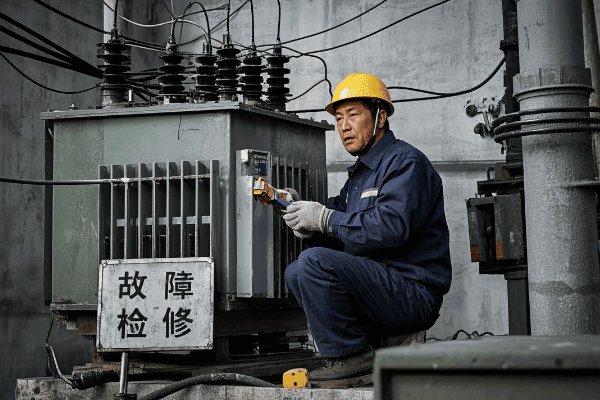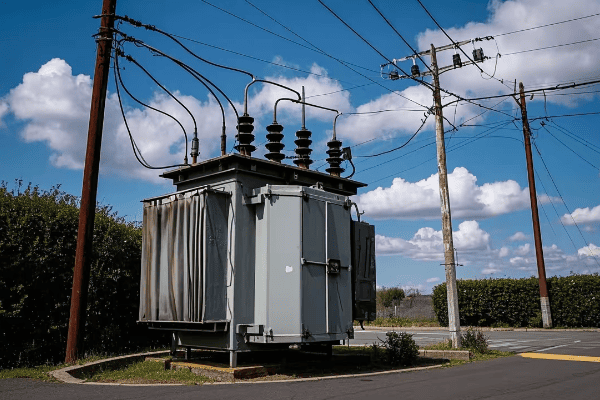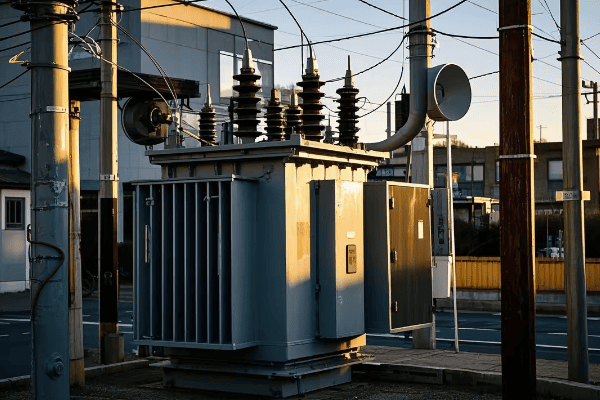Electric Transformer: The Silent Powerhouse of Energy Distribution?
Have you ever wondered how electricity reaches your home safely? The answer lies in a device that works tirelessly behind the scenes: the electric transformer.
Electric transformers are the unsung heroes of our power grid. They change voltage levels, making it possible to send electricity over long distances and deliver it safely to our homes and businesses.

As an electrical engineer with years of experience in the power industry, I’ve seen firsthand how crucial these devices are. Let’s explore the world of electric transformers and discover why they’re so important for our modern life.
How Do Electric Transformers Silently Revolutionize Energy Distribution Networks?
Imagine trying to send a text message across the country using only your voice. It wouldn’t work, right? That’s similar to the problem electric transformers solve for our power grid.
Electric transformers revolutionize energy distribution by changing voltage levels. They increase voltage for long-distance transmission, reducing energy losses. Then, they decrease voltage for safe use in homes and businesses.

Let’s break down how transformers work their magic:
The Basics of Transformer Operation
-
Electromagnetic Induction: This is the key principle behind transformers. When an alternating current flows through a wire, it creates a changing magnetic field. This field can induce a current in another nearby wire.
-
Primary and Secondary Coils: A transformer has two sets of wire coils. The primary coil receives the input power. The secondary coil delivers the output power.
-
Turns Ratio: The number of turns in each coil determines the voltage change. If the secondary coil has more turns than the primary, the voltage increases. If it has fewer turns, the voltage decreases.
Transformers in the Power Grid
Transformers play different roles at various points in the power grid:
-
Step-Up Transformers: At power plants, these increase voltage (often to 400,000 volts or more) for long-distance transmission.
-
Step-Down Transformers: At substations, these reduce voltage for local distribution.
-
Distribution Transformers: These further reduce voltage to levels safe for homes and businesses (typically 120/240 volts in the U.S.).
The Silent Revolution
Transformers revolutionize energy distribution in several ways:
-
Efficiency: By enabling high-voltage transmission, transformers dramatically reduce energy losses over long distances.
-
Safety: They make it possible to use dangerous high voltages for transmission while delivering safe low voltages to end-users.
-
Flexibility: Transformers allow the power grid to adapt to different voltage needs for various applications.
-
Reliability: By managing voltage levels, transformers help maintain a stable and reliable power supply.
The Diverse Family of Electric Transformers: From Substations to Your Doorstep
When I first started working with transformers, I was amazed by their variety. It’s like a family tree, with each type playing a unique role in getting power from the plant to your plug.
Electric transformers come in various types and sizes, each designed for specific roles in the power grid. From massive substation transformers to small pole-mounted units, they form a diverse family that works together to deliver electricity efficiently.

Let’s explore the main types of transformers you might encounter:
Power Transformers
These are the giants of the transformer world. You’ll find them in power plants and major substations.
- Size: Can be as large as a small house
- Capacity: Typically handle power from 5 MVA to over 1,000 MVA
- Voltage: Can work with voltages up to 765 kV or even higher
- Cooling: Often use oil for insulation and cooling
Distribution Transformers
These are the workhorses that bring power to your neighborhood.
- Size: Much smaller, often seen on utility poles or in green boxes on the ground
- Capacity: Usually range from 5 kVA to 5,000 kVA
- Voltage: Typically reduce voltage from 4-35 kV to 120/240 V for residential use
- Types: Include pole-mounted, pad-mounted, and underground transformers
Instrument Transformers
These specialized transformers help with measuring and protecting the power system.
- Current Transformers (CTs): Measure electric current
- Voltage Transformers (VTs): Measure voltage
- Use: Provide inputs for meters, relays, and other instruments
Special-Purpose Transformers
These transformers are designed for specific applications:
- Isolation Transformers: Provide electrical isolation for safety or noise reduction
- Autotransformers: Used for small voltage adjustments, often in voltage regulators
- Rectifier Transformers: Used in high-voltage direct current (HVDC) transmission systems
Here’s a quick comparison of the main transformer types:
| Type | Size | Capacity | Primary Use |
|---|---|---|---|
| Power | Very Large | 5-1000+ MVA | Transmission substations |
| Distribution | Small to Medium | 5-5000 kVA | Local power distribution |
| Instrument | Very Small | N/A | Measurement and protection |
| Special-Purpose | Varies | Varies | Specific applications |
Each type of transformer plays a crucial role in ensuring that electricity is delivered efficiently and safely from power plants to end-users. Understanding this diverse family helps us appreciate the complexity of our power distribution system.
Boosting Efficiency: Electric Transformers’ Role in Minimizing Energy Losses
Have you ever touched a warm phone charger? That warmth is wasted energy. Now imagine that on a massive scale – that’s the challenge transformers face.
Electric transformers play a crucial role in minimizing energy losses in power systems. They achieve this through efficient design, advanced materials, and strategic placement in the grid. Their effectiveness significantly impacts overall power system efficiency.

Let’s dive into how transformers help boost efficiency:
Understanding Transformer Losses
Transformers, despite being highly efficient, do experience some energy losses. These losses come in two main forms:
-
No-Load Losses (Core Losses):
- Occur when the transformer is energized but not supplying load
- Mainly due to the magnetization of the core
- Present 24/7, even when no power is being transmitted
-
Load Losses (Copper Losses):
- Occur when the transformer is supplying power
- Increase with the square of the load current
- Due to resistance in the transformer windings
Strategies for Minimizing Losses
Transformer manufacturers and power system engineers use several strategies to minimize these losses:
-
Advanced Core Materials:
- Use of grain-oriented silicon steel
- Amorphous metal cores for distribution transformers
- These materials reduce no-load losses
-
Improved Winding Design:
- Use of larger conductor cross-sections
- Advanced winding geometries
- These reduce load losses
-
Cooling Systems:
- Efficient oil circulation in oil-filled transformers
- Use of vegetable-based oils with better cooling properties
- Helps manage temperature and reduce losses
-
Load Management:
- Using multiple smaller transformers instead of one large one
- Allows for better matching of transformer capacity to load
-
Voltage Optimization:
- Maintaining voltage at the higher end of the acceptable range
- Reduces current for the same power, lowering load losses
The Impact of Transformer Efficiency
The efficiency of transformers has a significant impact on the overall power system:
-
Energy Savings: Even a small improvement in efficiency can lead to substantial energy savings given the large number of transformers in use.
-
Cost Reduction: Higher efficiency means less energy needs to be generated, reducing fuel costs and potentially lowering electricity prices.
-
Environmental Benefits: Improved efficiency leads to reduced carbon emissions from power generation.
-
Grid Stability: Efficient transformers help maintain voltage stability, improving overall grid reliability.
Here’s a simple example to illustrate the impact:
| Transformer Efficiency | Annual Energy Loss (for 1 MVA transformer) |
|---|---|
| 98% | 175,200 kWh |
| 99% | 87,600 kWh |
| 99.5% | 43,800 kWh |
As you can see, even a 1% improvement in efficiency can save a significant amount of energy over a year.
Regulations and Standards
Recognizing the importance of transformer efficiency, many countries have implemented minimum efficiency standards:
- United States: Department of Energy (DOE) standards for distribution transformers
- European Union: Ecodesign requirements for power transformers
- China: Minimum energy performance standards (MEPS) for distribution transformers
These regulations drive innovation in transformer design and manufacturing, pushing the boundaries of efficiency.
Powering the Green Revolution: Electric Transformers and Renewable Energy Integration
When I first started in this industry, renewable energy was a small part of the power mix. Now, it’s revolutionizing how we generate and distribute electricity. Transformers are at the heart of this green revolution.
Electric transformers play a crucial role in integrating renewable energy sources into the power grid. They handle the variable output of renewables, enable long-distance transmission from remote generation sites, and help maintain grid stability with fluctuating power inputs.

Let’s explore how transformers are adapting to and enabling the growth of renewable energy:
Challenges of Renewable Energy Integration
Renewable energy sources like wind and solar present unique challenges:
- Variability: Output can change rapidly based on weather conditions
- Remote Locations: Many renewable sources are far from population centers
- Bidirectional Power Flow: With distributed generation, power can flow both ways in the grid
- Power Quality: Inverters used in solar systems can introduce harmonics
Transformer Solutions for Renewable Energy
Transformers are evolving to meet these challenges:
-
Tap Changers for Voltage Regulation:
- Help manage voltage fluctuations from variable renewable output
- Some modern transformers have on-load tap changers for real-time adjustment
-
High-Voltage Direct Current (HVDC) Transformers:
- Enable efficient long-distance transmission from remote renewable sites
- Particularly useful for offshore wind farms
-
Phase Shifting Transformers:
- Help control power flow in the grid
- Useful for managing the integration of large renewable energy sources
-
Smart Transformers:
- Can adapt to changing grid conditions in real-time
- Help manage bidirectional power flow in grids with distributed generation
Transformer Design Considerations for Renewables
-
Overload Capacity:
- Designed to handle temporary overloads from renewable energy surges
- Use of advanced cooling systems to manage heat from variable loads
-
Harmonic Mitigation:
- Design features to handle harmonics introduced by inverters
- Use of K-factor ratings to indicate ability to handle harmonic heating
-
Efficiency at Partial Loads:
- Optimized to maintain high efficiency even when renewable sources are producing less power
-
Compact Designs:
- For use in offshore wind platforms or solar farms where space is limited
Case Studies: Transformers in Renewable Energy Projects
-
Offshore Wind Farms:
- Use of specially designed transformers that can withstand marine environments
- Example: The Hornsea Project in the UK uses massive offshore substations with high-capacity transformers
-
Solar Farms:
- Use of multiple smaller transformers to optimize efficiency and reliability
- Example: The Noor Abu Dhabi solar plant uses numerous transformers to handle its 1.2 GW capacity
-
Hydroelectric Power:
- Use of generator step-up transformers to increase voltage for long-distance transmission
- Example: The Three Gorges Dam in China uses some of the world’s largest transformers
Future Trends
As renewable energy continues to grow, we can expect to see:
- More Flexible Transformer Designs: Able to handle a wider range of operating conditions
- Increased Use of Smart Features: For better integration with smart grid systems
- Development of Solid-State Transformers: Offering more control and flexibility for renewable integration
- Higher Capacity HVDC Transformers: To support long-distance transmission from large renewable projects
Smart Transformers: The Future of Intelligent Energy Distribution Systems
When I first heard about smart transformers, I was skeptical. How could a simple electromagnetic device become "smart"? But as I’ve seen them in action, I’ve become a believer in their potential to revolutionize our power grids.
Smart transformers are advanced power devices that combine traditional transformer technology with digital control systems. They can monitor their own condition, adjust to changing load demands, and communicate with other grid components, enabling more efficient and reliable power distribution.

Let’s explore the world of smart transformers and how they’re shaping the future of energy distribution:
What Makes a Transformer "Smart"?
Smart transformers incorporate several advanced features:
-
Sensors and Monitoring:
- Real-time monitoring of voltage, current, temperature, and oil condition
- Early detection of potential issues
-
Communication Capabilities:
- Can send and receive data from control centers
- Enables integration with smart grid systems
-
On-Load Tap Changers:
- Ability to adjust voltage levels in real-time
- Helps manage voltage fluctuations from renewable sources
-
Power Electronics:
- Some designs incorporate power electronic components
- Allows for more precise control of power flow
Benefits of Smart Transformers
-
Improved Grid Stability:
- Can quickly respond to changes in load or power quality
- Helps prevent outages and voltage issues
-
Enhanced Energy Efficiency:
- Optimizes power flow to reduce losses
- Can adjust operation based on real-time grid conditions
-
Better Asset Management:
- Provides data for predictive maintenance
- Helps extend transformer lifespan
-
Facilitates Renewable Integration:
- Can handle bidirectional power flow from distributed generation
- Manages voltage fluctuations from variable renewable sources
-
Enables Demand Response:
- Can adjust to demand response signals
- Helps balance grid load during peak times
Smart Transformer Technologies
Several technologies contribute to making transformers smart:
-
Solid-State Transformers (SSTs):
- Use power electronics to convert AC to DC and back to AC
- Offer more control over power quality and flow
- Still in development for large-scale applications
-
Digital Twin Technology:
- Creates a virtual model of the transformer
- Allows for simulation and predictive analysis
-
Artificial Intelligence and Machine Learning:
- Used for predictive maintenance and optimization
- Can learn from historical data to improve performance
-
Blockchain Integration:
- Some projects are exploring using blockchain for secure data sharing
- Could enable new models for energy trading and grid management
Challenges and Considerations
While smart transformers offer many benefits, there are challenges to their widespread adoption:
- Cost: Smart transformers are more expensive than traditional ones
- Complexity: More components mean more potential points of failure
- Cybersecurity: Increased connectivity raises cybersecurity concerns
- Standardization: Lack of universal standards for smart grid communication
Future Outlook
The future of smart transformers looks promising:
- Grid Modernization: Smart transformers will play a key role in upgrading aging power infrastructure
- Microgrid Support: Will enable better integration and management of microgrids
- Electric Vehicle Integration: Will help manage increased loads from EV charging
- Energy Storage Integration: Could incorporate energy storage capabilities for load balancing
As we move towards a more renewable, distributed, and intelligent power grid, smart transformers will be at the forefront of this transformation, enabling a more efficient, reliable, and flexible energy future.
Conclusion
Electric transformers are indeed the silent powerhouses of our energy distribution systems. From traditional designs to smart technologies, they play a crucial role in powering our world efficiently and reliably. As we move towards a greener, more connected future, transformers will continue to evolve, enabling the smart grids of tomorrow.
Free CHBEB Transformer Catalog Download
Get the full range of CHBEB transformers in one catalog.
Includes oil-immersed, dry-type, pad-mounted, and custom solutions.
Quick Message
Request A free quote
We'd like to work with you
- +86 15558785111
- [email protected]
- +86 15558785111
What We Do
CHINA BEI ER BIAN (CHBEB) GROUP, with 218 million in registered capital, originated from Beijing Beierbian Transformer Group. Headquartered in Beijing for R&D, it operates major production bases in Nanjing and Yueqing, producing high-quality products.
Latest Product
address
BeiJing
No 3,RongJing East Road,BeiJing Economic Technological Development Area,BeiJing,China
JiangSu
No 7️Xiangfeng Road,Jiangning,NanJing,JiangSu,China
WenZhou
No.211, Wei 16 Road, Industrial Zone, Yueqing, Wenzhou, Zhejiang, China.
XiangYang Industrial Zone ,YueQing,WenZhou,ZheJiang,China
contact us
- [email protected]
- +86 13057780111
- +86 13057780111
- +86 15558785111
Copyright © Bei Er Bian Group


